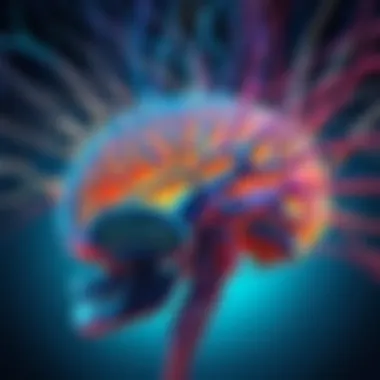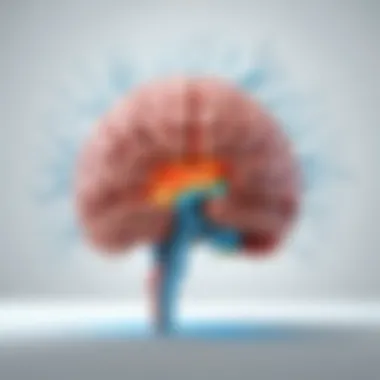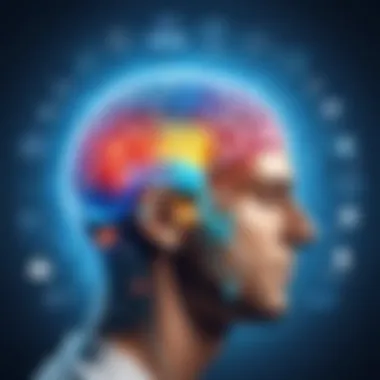Exploring Stress in the Brain: Mechanisms and Effects


Intro
In today's fast-paced world, stress seems to have become a part and parcel of our daily lives. It lurks in every corner, waiting to strike when we least expect it. But what really happens to our brains when we are stressed? Understanding this complex interaction is not only crucial for mental health but also important for overall well-being.
Stress does not merely impact feelings of anxiety or restlessness; it has profound effects on our brain's functionality. From altering our memory to influencing emotional responses, the ramifications of stress are vast and significant. In this article, we'll take a deep dive into the mechanisms that govern stress response in the brain. By examining the interplay of biology and behavior, we can shed light on how chronic stress affects mental health and what can be done to alleviate these consequences.
The intriguing aspect of exploring stress is the blend of scientific understanding with practical implications. How can innovations in tech help monitor or manage stress? What strategies can mitigate its impact on our brain health? These questions will guide our exploration, as we seek to uncover the nuances of stress—from molecular mechanisms to potential interventions. So, let’s embark on this journey, dissecting the stress phenomena, its implications, and what we can do about it.
Conceptualizing Stress
Understanding stress is foundational when examining its multifaceted impact on brain function. Stress, in a broad sense, refers to the body's response to any demand or threat, whether it be physical, emotional, or psychological. In this article, we aim to unravel not just what stress is, but also the implications it carries for mental health and cognitive functioning.
Defining stress sets the stage for a deeper exploration of its types. It helps in categorizing the various forms stress can take, such as acute and chronic stress, allowing for a more structured discussion on their distinct effects on brain processes. The different types of stress also come with unique traits and consequences, intertwining them deeply with the neurobiological mechanisms we will examine.
Moreover, recognizing how stress operates can guide us in developing effective strategies to manage it. From lifestyle changes to cognitive-behavioral therapy, the benefits of understanding stress proliferate, allowing individuals to take charge of their mental well-being. This article will provide a rounded view of stress that not only focuses on its negative impacts but also sheds light on the positive forms of stress, known as eustress, which can be harnessed for growth and personal development.
"Stress is not just an enemy; it can also be a catalyst for change and resilience."
Whether you're a tech-savvy individual, someone who enjoys exploring the latest gadgets, or just curious about the dynamics of brain function, understanding stress and its implications is critical. It influences how we think, feel, and ultimately act, making it a crucial area of study in today’s fast-paced, high-pressure environment.
Defining Stress
Stress can be defined as a state of mental or emotional strain resulting from challenging or adverse circumstances. It involves both physiological and psychological responses. When someone encounters a stressor, the body reacts with a complex array of changes designed to help it cope. This is where terms like fight or flight come into play, encompassing both the alarm response and the subsequent adaptations that occur in the face of pressure. Thus, stress is both a response and a set of changes that imply a deep interaction between mind and body.
Types of Stress
Acute Stress
Acute stress is a short-term response to an immediate threat; the body reacts quickly, releasing adrenaline and cortisol. This reaction is crucial as it prepares an individual to face danger or escapre. It’s commonly experienced during daily activities, such as public speaking or exams. The key characteristic of acute stress is its temporariness; while it can be intense, once the pressure subsides, the body returns to its normal state. This makes acute stress a beneficial choice when viewed through the lens of performance enhancement, as it can increase focus and energy levels. However, the downside is that if the acute stressors pile up without appropriate coping mechanisms, they may start impinging on mental health.
Chronic Stress
Chronic stress, on the other hand, hangs around longer. When stressors are recurrent or continuous—think of ongoing workplace pressure or long-term relationship issues—this form emerges. Chronic stress has significant implications for brain function and mental health. One critical aspect is that it triggers sustained high levels of cortisol, which can lead to issues such as memory impairment and emotional disturbances. This form of stress is less manageable but crucial to understand as it correlates directly with various mental health disorders. The real crux lies in its insidious onset. Small daily stresses can accumulate, causing long-term bodily changes that may go unnoticed.
Eustress vs. Distress
When speaking about stress, distinguishing between eustress and distress is valuable. Eustress is often regarded as the "good" stress that motivates and energizes people, enhancing performance and stimulating growth. For instance, preparing for an important presentation may induce eustress, pushing an individual to excel. Conversely, distress refers to the negative form of stress that can provoke anxiety and prevent optimal functioning. It often arises from overwhelming pressures that lead to feelings of helplessness. Understanding this distinction provides insights into harnessing stress effectively while also advocating for necessary interventions when distress becomes unmanageable.
Emphasizing the types of stress is not a mere academic exercise; it holds real-world relevance for tech-savvy individuals or anyone in a demanding environment. By recognizing how different kinds of stress affect daily lives and cognitive functions, everyone has the chance to make informed choices that can lead to improved health and well-being.
Neuroscience of Stress
Understanding the neuroscience of stress is crucial, primarily because stress is not just a psychological phenomenon; it’s deeply embedded within biological processes that govern our reactions to various stimuli. Stress can manifest due to daily life pressures or significant traumatic events, and recognizing its intricacies helps illuminate the path toward managing its adverse effects.
The study of the brain and its functions during stress response offers valuable insights into how we can better support mental health. By examining both the stress response system and the role of neurotransmitters and hormones, this section aims to narrate the underlying mechanisms of stress and its profound implications for mental health.
Stress Response System
The stress response system plays a pivotal role when it comes to how our bodies react to stressors. It consists mainly of the Hypothalamic-Pituitary-Adrenal Axis and the Sympathetic Nervous System, both of which coordinate the body’s response to stress. To grasp the enormity of their impact, let's delve deeper into each component.
Hypothalamic-Pituitary-Adrenal Axis
The Hypothalamic-Pituitary-Adrenal Axis, commonly referred to as the HPA axis, is a primary component of the human stress response. When faced with stress, the hypothalamus releases corticotropin-releasing hormone, which signals the pituitary gland to produce adrenocorticotropic hormone, ultimately prompting the adrenal glands to secrete cortisol. This cascade triggers a variety of physiological responses, steering the body toward a state of heightened alertness.
What sets the HPA axis apart is its lasting effects. While immediate responses like increased heart rate are crucial, the long-term elevation of cortisol can lead to adverse outcomes such as anxiety and depression. This makes the HPA axis not only a fascinating area of study but also a beneficial focal point in discussions about stress management strategies.
The principal advantage of understanding the HPA axis in the context of stress is the potential for intervention. By manipulating cortisol levels, researchers are exploring ways to mitigate the cascade inherent in stress responses, thus offering hope for improved mental health outcomes.
Sympathetic Nervous System
On the flip side, we have the Sympathetic Nervous System (SNS), often viewed as the body's "fight or flight" system. When stress strikes, the SNS kicks into gear, rapidly mobilizing energy and resources to prepare the body for an immediate reaction. It increases heart rate, dilates pupils, and boosts blood flow to muscles, all crucial for survival in dangerous situations.
The unique characteristic of the SNS is its immediate response to threat, making it invaluable in emergency situations. However, if the SNS remains activated for prolonged periods due to chronic stress, it can lead to health complications like hypertension or metabolic disorders.
Studying the SNS provides a beneficial lens through which we can recognize both acute and chronic implications of stress. The advantage here lies in understanding that stress management techniques—like deep breathing or yoga—can mitigate the overactivity of the SNS, promoting a state of calm.
Neurotransmitters and Hormones
Neurotransmitters and hormones are the chemical messengers that orchestrate the stress response. Focusing on central players like cortisol, adrenaline, and serotonin, we can appreciate their contributions to the overall understanding of stress.
Cortisol
Cortisol's role is paramount in relation to stress. This glucocorticoid hormone helps regulate metabolism, immune responses, and plays a critical part in how the body handles stress. As the body’s main stress hormone, it is released in response to signals from the HPA axis and acts as a modulator of numerous body systems.
Its well-known beneficial effect is the enhancement of memory and alertness in acute stressful situations, but the flip side lies in chronic elevation, which can wreak havoc on mental and physical health. Prolonged cortisol levels can lead to cognitive impairments and amplify feelings of anxiety and depression.
Adrenaline
For many, Adrenaline is synonymous with high-energy responses to stress. Secreted by the adrenal glands during stressful situations, adrenaline floods the system, preparing the body for battle or flight. Its key characteristic is the rapid onset of action, making it powerful in acute scenarios where immediate energy is essential.
While its capability to boost performance temporarily is a distinct advantage, the drawback comes with its contribution to an overstimulated nervous system when stress becomes chronic. Balancing adrenaline's effects through lifestyle choices is critical.


Serotonin
Finally, Serotonin often lauded as a mood stabilizer, is essential in our discussion of stress. It’s primarily recognized for its role in regulating mood, emotions, and sleep. While serotonin is frequently associated with feelings of well-being, its efficacy dips during prolonged or chronic stress due to alterations in its production and function.
The significant benefit of serotonin lies in its ability to buffer the negative effects of stress, suggesting that strategies to enhance serotonin levels—like exercise or therapy—could be beneficial for those grappling with stress-related conditions. Conversely, disruptions in serotonin levels can severely affect mental health, intensifying anxiety and depression.
An understanding of the roles played by the HPA axis, SNS, cortisol, adrenaline, and serotonin empowers us by providing tangible avenues for improving health amid stressful environments.
Impact on Brain Function
Understanding how stress impacts brain function is crucial for various fields, including psychology, neuroscience, and even education. Stress isn't just a hurdle; it shapes our cognition and emotional well-being in profound ways. By dissecting the influence of stress on memory, cognitive abilities, and emotional regulation, we open a window into the intricate workings of the brain under pressure.
When stress descends, it can trigger a cascade of effects that could either hinder or enhance performance. For example, while acute stress might sharpen focus temporarily, chronic stress is usually detrimental, leading to cognitive impairment and emotional difficulties. This dual nature of stress presents a fascinating landscape worthy of exploration, underscoring why this topic holds significance in both academic and practical realms.
Effects on Memory
Memory is the currency of our cognitive life. Stress can play tricks on it, affecting both short-term and long-term recall in different ways.
Short-term Memory
Short-term memory serves as a temporary holding space, often for tasks at hand. Under stress, this type of memory may become costlier than usual. An important aspect to highlight is how acute stress, while detrimental, can also lead to a temporary boost in focus. This effect can create a sharp edge, enabling a person to concentrate better in the moment, which can be advantageous in situations like exams or public speaking.
However, this unique feature comes with drawbacks; prolonged stress can diminish short-term memory efficiency over time. When the brain is overwhelmed with cortisol—the body's main stress hormone—it struggles to retain the information as it should.
Long-term Memory
Moving on to long-term memory, which involves the storage and recall of information over extended periods. Chronic stress poses particular challenges here, often leading to the deterioration of memory capabilities. What stands out about long-term memory is its reliance on neuroplasticity—the brain's ability to rewire itself. Stress can hamper this process, reducing the brain's ability to forge new connections.
Thus, while the brain seeks to retain experiences and knowledge, chronic stress can obstruct these pathways, making recall less reliable. This damage, over time, can have significant implications on personal and professional lives, altering one’s perception and experiences.
Cognitive Impairment
Cognitive impairment reverberates across various domains of life, largely stemming from stress's effects on attention and decision-making. Identifying these impairments is essential, as they impact everyday functioning.
Attention Deficits
Attention deficits manifest as difficulty concentrating on tasks, a phenomenon many can relate to during stressful periods. Stress corrupts the brain’s ability to filter out distractions, leaving a muddled cognitive state. One of the key characteristics of these deficits is their persistence; once established, they can linger long after stressors have lifted.
This highlights a critical concern: what begins as temporary distractions can evolve into prolonged issues affecting productivity and overall quality of life.
Decision Making
Decision-making is another aspect where stress casts a long shadow. High-stress situations may lead individuals to rely on gut instincts rather than thoughtful deliberation. The important point here is that stress can skew the evaluation of options, often resulting in riskier choices.
Unique to this scenario is the interplay between the emotional and cognitive brain regions, which may collide, causing a breakdown in what we might call rational decision-making. For someone trying to navigate life choices under pressure, the implications can be daunting.
Emotional Regulation
Emotional regulation can be seen as the brain's ability to manage emotional responses. Stress wreaks havoc in this domain, leading to various psychological disturbances.
Anxiety Disorders
Anxiety disorders are frequently intertwined with stress, as the latter often acts as a trigger. Individuals experiencing high stress can find themselves caught in a cycle of worry and apprehension, perpetuating a state of heightened anxiety. What’s noteworthy about anxiety disorders is their prevalence in society today, affecting a significant portion of the population.
Unique to this facet is the double-edged sword of stress: while it can highlight concerns that need addressing, chronic anxiety can further complicate life, creating a vicious cycle.
Depression
Finally, depression represents another significant outcome of stress. Chronic stress can lead to changes in brain chemistry that contribute to feelings of hopelessness and sadness. A key characteristic of depression in the context of stress is its complexity; it doesn't merely stem from overwhelming stimuli but often from the cumulative effects of daily pressures.
The unique feature of this relationship lies in how stress influences neurotransmitter levels, particularly serotonin, which plays a pivotal role in mood regulation. Understanding this connection is critical, as it positions stress as a potential foundational element in treating depressive symptoms.
Chronic Stress and Physiological Changes
The exploration of chronic stress and its physiological changes is critical to understanding how prolonged stress impacts the brain and the body. This subject significantly influences mental health, cognition, and overall well-being. Chronic stress doesn't just sit idly; it triggers a cascade of biological reactions that affect everything from neurotransmitter levels to brain structure. This section will dissect these mechanisms, looking closely at how they reshape our neurological landscape.
Neuroplasticity and Stress
Structural Changes
Structural changes refer to the physical alterations within the brain due to stress over time. This facet of neuroplasticity showcases how adaptable our brain can be when faced with challenges. Chronic stress can lead to decreased volume in critical areas like the hippocampus, known for its role in memory and learning. This atrophy can contribute to cognitive decline, a common symptom in stressed individuals.
The key characteristic of these structural changes is their long-lasting nature; the results of chronic stress can persist even when the stressor is removed, affecting cognitive function and emotional regulation. Such alterations can serve as a sober reminder of the importance of stress management. The unique feature here is that while the brain can adapt and change, the direction of structural change under stress is often detrimental. It’s one of the disadvantages of this adaptability: when under continual stress, negative structural changes become the norm rather than the exception.
Functional Alterations
Moving on, functional alterations capture the changes in how the brain operates due to chronic stress. This can manifest in the way regions of the brain communicate or fail to communicate effectively. Functional alterations can occur through a reduction in synaptic connectivity, leading to difficulties in processing information and responding to emotional stimuli.
The key characteristic here is that these changes can lead to widespread issues, ranging from impairments in attention to emotional outbursts. This renders functional alterations a compelling focus for researchers in understanding stress-related disorders. A unique aspect is the potential for recovery; while these alterations can impair function, there are avenues for rehabilitation through positive interventions. This hopeful vista points out the advantages of exploring functional changes, as it opens potential pathways for recovery.
Inflammatory Responses
Cytokine Release


In the context of stress, cytokine release stands as a significant player. These small proteins, released by cells, play a crucial role in cellular signaling during inflammation. When stressed, our body tends to unleash a flurry of cytokines, leading to inflammatory responses that can alter brain function and health.
The key characteristic of cytokine release is its established correlation with mood disorders, particularly when stress becomes chronic. Chronically elevated cytokines can disrupt neurotransmitter systems, laying the groundwork for anxiety and depression. This makes discussing cytokine release particularly beneficial for understanding stress impacts. However, the unique feature is the dual role they play: while they are essential for immune response, their overproduction can contribute to detrimental outcomes. The consequence of this release is a heightened state of inflammation, which could spiral into various health issues, especially in mental well-being.
Impact on Neurogenesis
Lastly, the impact on neurogenesis reveals how chronic stress influences the brain's ability to regenerate new neurons. Typically, neurogenesis occurs primarily in the hippocampus, an area crucial for learning and memory. Chronic stress can significantly inhibit this process, leading to cognitive deficits and emotional instability.
The key characteristic of this impact is that it highlights how stress can stagnate growth in an otherwise thriving environment. Understanding neurogenesis provides a beneficial entry point for interventions aimed at enhancing brain resilience. The unique feature of this is its focus on rejuvenation; while stress can impede neurogenesis, strategies such as mindfulness and physical activity can bolster it back. This demonstrates the advantages of recognizing stress’s impact on neural growth and how proactive approaches can potentially reverse or mitigate negative consequences.
"Chronic stress doesn’t merely follow you; it embeds itself deep within, reshaping how you think and feel."
This section aims to peel back the layers of this complex interaction between stress and physiological changes. Understanding these processes leads us to finely tune approaches in managing stress, emphasizing that recovery is not only possible—it is essential to improving mental health.
Stress and Mental Health
Understanding the interplay between stress and mental health is crucial in grasping the full scope of how our brains and bodies respond to pressure. Stress doesn't just exist in a vacuum; it saturates our emotional and psychological states, potentially leading to debilitating issues like anxiety and depression.
The significance of this section lies in its exploration of how stress acts as a catalyst for mental health disorders. It emphasizes the necessity for strategies that not only mitigate stress but directly address its mental health implications. Recognizing that stress is both an external and internal trigger provides a framework for better mental health outcomes. Breaking down this relationship further allows us to identify those who may be at greater risk and helps underscore the importance of intervention.
Stress and Anxiety
Prevalence of Anxiety Disorders
Anxiety disorders are alarmingly common in today’s society. Statistics suggest that nearly one in five adults experiences an anxiety disorder annually. This high prevalence indicates that stress is not merely an occasional inconvenience but a significant factor in the daily lives of many. The connection between general stress and anxiety disorders emphasizes the urgency in our understanding of stress management strategies.
Key to grasping the prevalence of anxiety disorders is recognizing how they differ broadly among populations. Factors such as age, gender, and socioeconomic status can influence these rates. For instance, studies have shown that women are statistically more likely to experience anxiety disorders than men, highlighting the need for targeted approaches to mental health support. The unique feature here is the amalgamation of various contributing factors, making this topic a focal point for research and intervention.
- Key features of anxiety prevalence include:
- Advantages include:
- High rates among adults: This raises the need for public awareness and education.
- Gender disparity: Women often report higher anxiety levels, inviting tailored approaches for treatment.
- Better understanding leads to improved interventions and coping strategies.
Role of Stress in Anxiety Development
Stress plays a pivotal role in the cascade leading to anxiety disorders. The connection is straightforward yet complex; chronic stress can alter brain chemistry, leading to heightened anxiety responses. This particular relationship is significant because it amplifies the need for proactive stress management techniques.
A noteworthy aspect of this relationship is that acute stressors can often trigger anxiety symptoms, while chronic stress continually feeds into an anxious mentality. Understanding this dynamic is advantageous for mental health professionals. It enables them to identify potential triggers and work with individuals to address these stress points effectively.
- Relevant considerations involve:
- The implication of this understanding is profound, as it underscores prevention and early intervention in anxiety disorders.
- Identifying triggers: Helps in tailoring individual coping strategies.
- Neurochemical changes: Knowing how stress alters brain function aids in treatment plans.
Stress and Depression
Connection to Major Depressive Disorder
The link between stress and Major Depressive Disorder (MDD) is well-documented and exemplifies how mental health issues can often be intertwined. Stressful life events can precipitate depressive episodes, especially in individuals with a predisposition to mood disorders. More frequently, chronic stress is a direct pathway leading to depression, offering critical insights into the mechanisms behind these conditions.
Understanding the nuances of stress as a precursor to MDD allows healthcare providers to approach treatment holistically. It signals a need for integrated care models that address both stress and mood disorders together. The unique feature here is the cyclical nature of stress-depression interaction, where one condition exacerbates the other.
- Considerations of this connection include:
- Causative link: Stress’s role as a trigger for major depressive episodes, necessitating intervention.
- Co-occurring conditions: Understanding how other mental health issues may compound depressive symptoms.
Biological and Psychological Factors
Both biological and psychological factors play significant roles in the stress-depression dynamic. Biologically, neurotransmitter imbalances due to prolonged stress can lead to symptoms of depression. Meanwhile, psychologically, the way individuals perceive and cope with stress affects their vulnerability to depressive disorders. Awareness of these facets can empower individuals and practitioners to create more effective therapeutic strategies.
The unique aspect of this discussion is the interplay of these elements, revealing that it’s not just about managing external stressors but also addressing internal cognitive processes. This dual focus aids in developing well-rounded mental health approaches.
- Key factors to consider include:
- Neurotransmitter levels: Understanding the biological basis can inform medication and therapy options.
- Coping mechanisms: This offers pathways for cognitive-behavioral interventions.
In essence, examining stress’s intricate ties to mental health reveals pathways for prevention, treatment, and understanding of anxiety and depression. The takeaway here is clear: managing stress is not just about feeling better today; it’s also essential for long-term mental health and well-being.
Strategies to Mitigate Stress
The significance of strategies to mitigate stress cannot be overstated, particularly in today's fast-paced world. Stress often feels like an inevitable part of life, but the method of handling it can dictate personal well-being and overall mental health. By focusing on effective techniques, individuals can better manage their responses to stressors, thus alleviating the burden that stress places on the brain. This section will delve into two primary domains: cognitive-behavioral methods and lifestyle modifications, both of which offer practical solutions to counteract stress.
Cognitive-Behavioral Approaches
Cognitive-behavioral approaches have gained traction for their systematic method of changing negative thought patterns associated with stress. These strategies not only provide coping techniques but cultivate resilience in the face of life's inevitable ups and downs.
Resilience Training
Resilience training aims to bolster an individual's ability to bounce back from challenges. The essence of this training lies in developing a positive mindset and adaptive skills to face adversity. One key characteristic of resilience training is its focus on personal growth rather than merely enduring stress. This shift in perspective creates a foundation from which individuals can thrive, rather than just survive.
- Unique Feature: Resilience training involves practical exercises and skills that can be learned, which are applicable in real-world scenarios.
- Advantages: This approach not only helps in reducing stress but also enhances emotional strength and promotes better relationships.
- Disadvantages: Notably, resilience training may not yield instant results; it requires consistent practice and time to see significant changes.
Mindfulness Practices


Mindfulness practices encompass a variety of techniques aimed at fostering awareness of the present moment, which is crucial in alleviating stress. The key aspect of mindfulness is its ability to ground individuals, drawing attention away from ruminative thoughts that can spiral into anxiety. Its popularity stems from simplicity; anyone can engage in mindfulness through meditation, breathing exercises, or even being present during daily activities.
- Unique Feature: One beauty of mindfulness is its accessibility — it can be done anywhere and at any time, making it a versatile tool for stress management.
- Advantages: Research has shown that regular mindfulness practices can lead to decreased symptoms of anxiety and depression while improving overall emotional well-being.
- Disadvantages: However, some may find it challenging to maintain focus during practices, requiring patience and practice to see benefits.
Lifestyle Modifications
Lifestyle modifications target the daily habits that can contribute to or alleviate stress. By changing these habits, individuals can create a more supportive environment for managing stress more effectively.
Dietary Changes
Dietary changes can profoundly impact both physical health and mental well-being. A balanced diet rich in omega-3 fatty acids, antioxidants, and proper hydration can contribute positively to brain function and, consequently, stress levels. This is particularly relevant because nutrition affects neurotransmitter activity, which plays a vital role in mood regulation.
- Key Characteristic: The focus on whole, nutrient-dense foods sets dietary changes apart; it emphasizes fueling the body for optimal functioning rather than just eating for satisfaction.
- Advantages: Incorporating nutritional strategies not only helps in stress management but also boosts energy levels, cognitive function, and general health.
- Disadvantages: Adopting new dietary habits can be overwhelming and may initially feel harder to sustain without gradual integration into one’s lifestyle.
Physical Activity
Physical activity serves as a powerful antidote to stress. Exercise releases endorphins, the body's natural stress relievers, promoting a sense of well-being. The concept of moving one's body to clear the mind is widely acknowledged, and it has proven to be an effective approach.
- Key Characteristic: The key aspect of physical activity lies in its ability to be tailored to individual preferences, whether through rigorous workouts or gentle yoga.
- Advantages: Regular movement can yield numerous benefits, including improved mood, better sleep patterns, and even enhanced cognitive function, all contributing factors to lowering stress levels.
- Disadvantages: On the flip side, time constraints and sedentary lifestyles can present significant barriers to regular exercise, requiring innovative solutions to fit activity into busy schedules.
Stress does not have to be a constant companion. By exploring and implementing these strategies, individuals can reclaim agency over their mental health, leading to profound changes in their lives.
Future Directions in Stress Research
Stress research is continually evolving, becoming an intersection where various fields meet to comprehend the intricacies of brain function under duress. The significance of exploring new avenues in this area cannot be overstated. As our understanding of stress deepens, it becomes crucial to investigate interdisciplinary approaches and technological innovations that can shed light on this multifaceted issue. The exploration of future directions aims to yield not only academic insights but also practical applications that can improve health outcomes. This section emphasizes the need for continued research that wheels back to the core mechanics of how stress manifests in various contexts and affects mental well-being.
Interdisciplinary Approaches
Neuroscience and Psychology
The synergy between neuroscience and psychology offers a profound understanding of stress’s impact on the brain. Neuroscience digs into the brain's biological responses, looking at how stress alters neural circuits and neurotransmitter levels. Psychology, meanwhile, dares to understand the subjective experience of stress and how cognitive processes influence emotional responses. This dual lens provides a comprehensive view, making it an excellent choice for examining stress.
Key Characteristics of This Approach:
- Integration of Science: Both disciplines utilize evidence-based approaches, blending biological research with behavioral insights.
- Benefit to Understand Stress: By merging the mechanistic findings of neuroscience with the experiential aspects explored by psychology, researchers can design more effective interventions that consider both the physiological and psychological dimensions of stress.
A unique feature of this interdisciplinary approach is its robustness in creating targeted treatments. By understanding how individuals experience stress, we can tailor therapies that address both the biology and the person’s lived experience. However, the integration also presents challenges; differing methodologies and terminologies can complicate collaboration between researchers from each discipline.
Public Health Initiatives
Public health initiatives play a pivotal role in tackling stress on a community level. These initiatives focus on prevention and education, emphasizing the need to address stressors before they become detrimental. They can influence changes in policy and community programming aimed at reducing stress, such as promoting mental health awareness and access to resources.
Key Characteristics of These Initiatives:
- Community Focus: This approach is centered around population health, looking at how social, economic, and environmental factors contribute to stress.
- Benefit to Society: Public health strategies improve overall community resilience. They aim to equip individuals with the skills necessary to manage stress effectively, resulting in healthier popualtions.
The unique feature of public health initiatives lies in their broad reach and potential for large-scale impact. While targeted interventions are beneficial for individuals, a public health approach can address systemic issues contributing to stress. Nonetheless, challenges might include resource allocation and varying community needs, which demand flexible and inclusive strategies.
Technological Innovations
Neurofeedback
Neurofeedback technology provides a fascinating avenue in stress management and research. This technique trains individuals to alter their brain activity through real-time feedback. Participants learn to adjust their neural functioning to decrease stress and improve focus, making it a compelling tool for managing stress-related disorders.
Key Characteristics of Neurofeedback:
- Self-Regulation: Individuals gain insight into their mental states, allowing them to cultivate greater emotional control.
- Customized Training: Neurofeedback treatments are tailored, enabling people to focus on specific stressors or brain functions relevant to their personal experience.
The unique aspect of neurofeedback is its potential for personalization, addressing individual brain patterns. However, the costs can be a hurdle for some, and further research is needed to solidify its efficacy across different populations.
Mobile Health Apps
Mobile health applications represent a modern approach to stress management, providing accessible resources right at our fingertips. These platforms offer various tools, such as guided mindfulness sessions, mood tracking, and stress management techniques. Their convenience makes them increasingly valuable for tech-savvy individuals.
Key Characteristics of Mobile Health Apps:
- Accessibility: With just a smartphone, users can access a wealth of information and resources anywhere, anytime.
- Engagement: Many apps incorporate gamified elements to keep users motivated, which can lead to sustained behavioral changes in stress management.
A standout feature of mobile health apps is their ability to connect users with a community for support. This social component can significantly enhance user experience, although there are concerns about the quality and reliability of information available on various platforms. Addressing these concerns will be key to ensuring credibility and effectiveness in stress management.
The future of stress research is bright, combining various disciplines and innovations that hold the promise of reducing the profound effects of stress on individuals and society at large.
Finale
Understanding how stress operates within the brain is no small feat. This article has covered various dimensions of stress, from its fundamental definitions to the potent effects it has on emotional health and cognitive function. Recognizing the toll that both acute and chronic stress take on the brain allows for a more profound appreciation of the necessity for effective stress management strategies. The nuances of the stress response, particularly the adaptive responses produced by our body, are complex but essential for maintaining long-term health and emotional wellbeing.
Summary of Key Findings
In summary, several key insights emerged from this exploration of stress:
- The stress response system, particularly the role of the hypothalamic-pituitary-adrenal axis, is foundational in shaping how we perceive and react to stressors. This system orchestrates a cascade of hormonal signals that prepare the body to respond to perceived threats.
- Distinct forms of stress, such as acute stress and chronic stress, exhibit different implications for cognitive processes. Acute stress can sometimes enhance performance and focus, while chronic stress often leads to debilitating impairments in memory and learning.
- The influence of neurotransmitters like cortisol, adrenaline, and serotonin underlines the intricate connection between stress and emotional regulation, showcasing how prolonged exposure to stress can induce conditions such as anxiety and depression.
Implications for Practice
The practical implications of understanding stress in the brain extend beyond academic curiosity; they offer pathways for intervention and improvement in personal and public health.
- Cognitive and Behavioral Strategies: Interventions grounded in cognitive-behavioral therapy can enhance resilience and mitigate the effects of stress through targeted techniques such as mindfulness and psychological support.
- Lifestyle Changes: Integrating regular physical activity and dietary modifications can bolster the body's resilience to stressors. A well-rounded diet rich in whole foods supports brain health, making individuals better equipped to handle stress.
- Importance of Awareness: For both individuals and practitioners, increasing awareness about the signs of stress and its biological underpinnings is paramount. Early identification can lead to timely interventions, diminishing the risk of chronic stress's ramifications on health.
As we continue to unravel the complexities of stress, it becomes clear that a holistic and interdisciplinary approach will be essential in addressing the myriad challenges posed by stress in our contemporary world. Understanding these dynamics not only benefits individual health but also fosters better community well-being.







